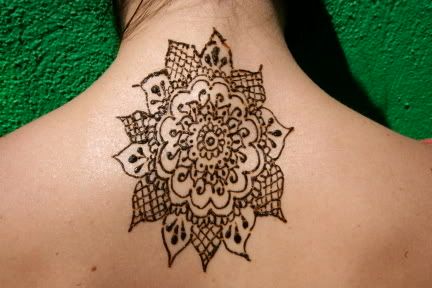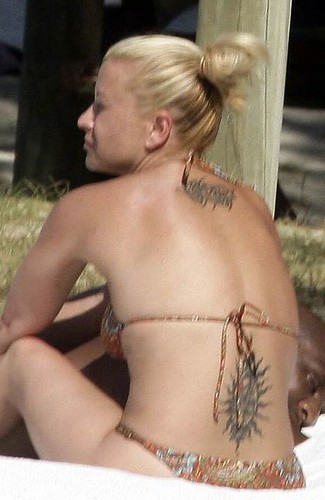


Henna or Hina (Lawsonia inermis, syn. L. alba) is a flowering plant, the sole species in the genus Lawsonia in the family Lythraceae. It is native to tropical and subtropical regions of Africa, southern Asia, and northern Australasia in semi-arid zones. Henna is a tall shrub or small tree, 2–6 m high. It is glabrous, multibranched with spine tipped branchlets. Leaves are opposite, entire, glabrous, sub-sessile, elliptical, and broadly lanceolate (1.5–5.0 cm x 0.5–2 cm), acuminate, having depressed veins on the dorsal surface. During the onset of precipitation intervals, the plant grows rapidly; putting out new shoots, then growth slows. The leaves gradually yellow and fall during prolonged dry or cool intervals. Henna flowers have four sepals and a 2 mm calyx tube with 3 mm spread lobes. Petals are obvate, white or red stamens inserted in pairs on the rim of the calyx tube. Ovary is four celled, style up to 5 mm long and erect. Fruits are small, brownish capsules, 4–8 mm in diameter, with 32–49 seeds per fruit, and open irregularly into four splits.[1] Lawsone content in leaves is negatively associated with the number of seeds in the fruits.[2]
Cultivation and uses
Henna, Lawsonia inermis, produces a red-orange dye molecule, lawsone. This molecule has an affinity for bonding with protein, and thus has been used to dye skin, hair, fingernails, leather, silk and wool. Henna's indigenous zone is the tropical savannah and tropical arid zone, in latitudes between 15° and 25° N and S from Africa to the western Pacific rim, and produces highest dye content in temperatures between 35°C and 45°C. It does not thrive where minimum temperatures are below 11°C. Temperatures below 5°C will kill the henna plant. The dye molecule, lawsone, is primarily concentrated in the leaves, and is in the highest levels in the petioles of the leaf. Products sold as "black henna" or "neutral henna" are not made from henna, but may be derived from indigo (in the plant Indigofera tinctoria) or Cassia obovata, and may contain unlisted dyes and chemicals.[3]
Henna is commercially cultivated in western India, Pakistan, Morocco, Yemen, Iran, Afghanistan, Somalia, Sudan and Libya. Presently the Pali district of Rajasthan is the most heavily cultivated henna production area in India, with over 100 henna processors operating in Sojat City.
Though henna has been used for body art and hair dye since the Bronze Age, henna has had a recent renaissance in body art due to improvements in cultivation, processing, and the diasporas of people from traditional henna using regions. [4]
The word "henna" comes from the Arabic name for Lawsonia inermis, pronounced /ħinnaːʔ/ or colloquially /ħinna/.
In the Bible's Song of Songs and Song of Solomon, henna is referred to as Camphire.
In the Indian subcontinent, there are many variant words such as Mehndi in North India, Pakistan and Bangladesh. In Telugu (India, Malaysia, USA), it is known as Gorintaaku. In Tamil (South India, Singapore, Malaysia, Sri Lanka) it is called "Marudhaani" and is used as ground fresh leaves rather than as dried powder. It is used in various festivals and celebrations and used by women and children. It is left on overnight and will last one month or more depending on the plant and how well it was ground and how long it is left on.
Henna has many traditional and commercial uses, the most common being as a dye for hair, skin and fingernails, as a dye and preservative for leather and cloth, and as an anti-fungal. Henna flowers have been used to create perfume since ancient times, and henna perfume is experiencing a resurgence on the Internet.[5] Henna was used as a hair dye in Indian court records around 400 CE,[6] in Rome during the Roman Empire, and in Spain during Convivienca.[7] It was listed in the medical texts of the Ebers Papyrus (16th c BCE Egypt)[8] and by Ibn Qayyim al-Jawziyya (14th c CE (Syria and Egypt) as a medicinal herb.[9] In Morocco, wool is dyed and ornamented with henna, as are drumheads and other leather goods. Henna will repel some insect pests and mildew.
The United States Food and Drug Administration has not approved henna for direct application to the skin. It is unconditionally approved as a hair dye, and can only be imported for that purpose.[10] Henna imported into the USA which appears to be for use as body art is subject to seizure, and at present it is illegal to use henna for body art in the U.S.,[11] though prosecution is rare. The fast black stains of “black henna” are not made with henna, but are from p-phenylenediamine. This can cause severe allergic reactions and permanent scarring. No henna can make a black stain on a torso in ½ hour. P-phenylenediamine can stain skin black quickly, but the FDA specifically forbids PPD to be used for that purpose.
Preparation and application of paste
Henna body art is made by applying henna paste to the skin: the lawsone in the paste migrates into the outermost layer of the skin and makes a red-brown stain.
Whole, unbroken henna leaves will not stain the skin. Henna will not stain skin until the lawsone molecules are made available (released) from the henna leaf. Fresh henna leaves will stain the skin if they are smashed with a mildly acidic liquid. This will stain skin within moments, but it is difficult to form intricate patterns from coarse crushed leaves. Dried ground, sifted henna leaves are easily worked into a paste that can be used to make intricate body art. Commercially available henna powder is made by drying the henna leaves and milling them to powder, then the powder is sifted. This powder is mixed with lemon juice, strong tea, or other mildly acidic liquids. Essential oils with high levels of "terps", monoterpene alcohols such as tea tree, eucalyptus, cajeput, or lavender will improve skin stain characteristics. The henna mix must rest for 6 to 12 hours so the leaf cellulose is dissolved, making the lawsone available to stain the skin. This is mixed to a toothpaste consistency and applied with a one of many traditional tools, including resist techniques, shading techniques, and thicker paste techniques, or the modern cellowrap cone.
Once applied to the skin, lawsone molecules gradually migrate from the henna paste into the outer layer of the skin. Though henna's lawsone will stain the skin within minutes, the longer the paste is left on the skin, the more lawsone will migrate. Henna paste will yield as much dye as the skin can easily absorb in less than eight hours. Henna tends to crack and fall off the skin during these hours, so it is often sealed down by dabbing a sugar/lemon mix over the dried paste, or simply adding some form of sugar to the paste. This also adds to the colour of the end result, increasing the intensity of the shade.
When the paste has fallen off the skin or been removed by scraping, the stain will be orange, but should darken over the following three days to a reddish brown. Soles and palms have the thickest layer of skin and so take up the most lawsone, and take it to the greatest depth, so that hands and feet will have the darkest and most long-lasting stains. Steaming or warming the henna pattern will darken the stain, either during the time the paste is still on the skin, or after the paste has been removed. Chlorinated water and soaps may spoil the darkening process: alkaline may hasten the darkening process. After the stain reaches its peak color it will appear to fade. The henna stain is not actually fading, the skin is exfoliating: the lower, less stained cells, rise to the surface, until all stained cells are shed.
Traditions of henna as body art
The different words for henna in ancient languages imply that henna had more than one point of discovery and origin, and different pathways of daily and ceremonial use.
Henna has been used to adorn young women’s bodies as part of social and holiday celebrations since the late Bronze Age in the eastern Mediterranean. The earliest text mentioning henna in the context of marriage and fertility celebrations comes from the Ugaritic legend of Baal and Anath [12], which has references to women marking themselves with henna in preparation to meet their husbands, and Anath adorning herself with henna to celebrate a victory over the enemies of Baal. Wall paintings excavated at Akrotiri (dating prior to the eruption of Thera in 1680 BCE) show women with markings consistent with henna on their nails, palms and soles, in a tableau consistent with the henna bridal description from Ugarit [13] Many statuettes of young women dating between 1500 and 500 BCE along the Mediterranean coastline have raised hands with markings consistent with henna. This early connection between young, fertile women and henna seems to be the origin of the Night of the Henna, which is now celebrated world-wide.
The Night of the Henna was celebrated by most groups in the areas where henna grew naturally: Jews, [14], Muslims[15], Hindus, Christians and Zoroastrians, among others, all celebrated marriages by adorning the bride, and often the groom, with henna.
Across the henna-growing region, Purim [14], Eid[16], Diwali[17], Karva Chauth, Passover, Nowruz, Mawlid, and most saints’ days were celebrated with some henna. Favorite horses, donkeys, and salukis had their hooves, paws, and tails hennaed. Battle victories, births, circumcision, birthdays, Zar, as well as weddings, usually included some henna as part of the celebration. When there was joy, there was henna, as long as henna was available. [15]
Henna was regarded as having “Barakah”, blessings, and was applied for luck as well as joy and beauty.[15] Brides typically had the most henna, and the most complex patterns, to support their greatest joy, and wishes for luck. Some bridal traditions were very complex, such as those in Yemen, where the Jewish bridal henna process took four or five days to complete, with multiple applications and resist work.
The fashion of "Bridal Mehndi" in Northern Libya and in North Indian diasporas is currently growing in complexity and elaboration, with new innovations in glitter, gilding, and fine-line work. Recent technological innovations in grinding, sifting, temperature control, and packaging henna, as well as government encouragement for henna cultivation, have improved dye content and artistic potential for henna.
Though traditional henna artists were Nai caste in India, and barbering castes in other countries (lower social classes), talented contemporary henna artists can command high fees for their work. Women in countries where women are discouraged from working outside the home can find socially acceptable, lucrative work doing henna. Morocco, Mauritania[18], Yemen, Libya, Somalia, Sudan, as well as India and many other countries have thriving women’s henna businesses. These businesses are often open all night for Eids, Diwali and Karva Chauth, and many women may work as a team for a large wedding where hundreds of guests will be hennaed as well as the bride and groom.
Health effects
Though user accounts cite few, if any, negative effects of natural henna paste, pre-mixed henna body art pastes may have ingredients added to darken stain, or to alter stain color. The health risks involved in pre-mixed paste can be significant. The FDA considers these to be adulterants and therefore illegal for use on skin.[19] Some pastes have been found to include: silver nitrate, carmine, pyrogallol, disperse orange dye, and chromium. These have been found to cause allergic reactions, chronic inflammatory reactions, or late-onset allergic reactions to hairdressing products and textile dyes.
- Medical report of heavy metals such as nickel, cobalt, chromium, lead and mercury found in henna tattoos [20]
- Allergies Associated with Body Piercing and Tattoos[21]
- OSHA on silver nitrate[22]
- CDC on silver nitrate[23]
Black henna
“Black Henna” is a misnomer arising from imports of plant-based hair dyes into the West in the late 19th century. Partly fermented, dried indigo was called “black henna” because it could be used in combination with henna to dye hair black. This gave rise to the belief that there was such a thing as “black henna” which could dye skin black. Indigo will not dye skin black. Pictures of indigenous people with black body art (either alkalized henna or from some other source) also fed the belief that there was such a thing as “black henna.”
In the 1990s, henna artists in Africa, India, the Arabian Peninsula and the West began to experiment with para-phenylenediamine (PPD) based black hair dye, applying it as a thick paste as they would apply henna, in an effort to find something that would quickly make jet black temporary body art. PPD can cause severe allergic reactions, with blistering, intense itching, permanent scarring, and permanent chemical sensitivities[24] [25]. Estimates of allergic reactions range between 3% and 15%. Henna does not cause these injuries[26]. Henna boosted with PPD can cause lifelong health damage. [27]
Para-phenylenediamine is illegal for use on skin in western countries, though enforcement is lax. When used in hair dye, the PPD amount must be below 6%, and application instructions warn that the dye not touch the scalp and the dye must be quickly rinsed away. “Black henna” pastes have PPD percentages from 10% to 60%, and are left on the skin for half an hour.
Para-phenylenediamine “black henna” use is widespread, particularly in tourist areas. Because the blistering reaction appears 3 to 12 days after the application, most tourists have left and do not return to show how much damage the artist has done. This permits the artists to continue injuring others, unaware they are causing severe injuries. The high profit margins of ‘black henna” and the demand for body art that emulates “tribal tattoos” further encourage artists to ignore the dangers. It is not difficult to recognize and avoid para-phenylenediamine “black henna”:
- if a paste stains torso skin black in less than ½ hour, it has PPD in it, and little or no henna.
- if the paste is mixed with peroxide, or if peroxide is wiped over the design to bring out the color, it has PPD in it, and little or no henna.
Anyone who has an itching and blistering reaction to a black body stain should go to a doctor, and report that they have had an application of para-phenylenediamine to their skin.
PPD sensitivity is lifelong, and once sensitized, the use of synthetic hair dye can be life-threatening [28]. These injuries are not caused by henna, and a person can use henna as hair dye.
Gallery
Source : http://en.wikipedia.org/wiki/Henna



 sores and blisters, because the reaction can occur up to 6 weeks after exposure. Also, skin hypersensitivity reactions will be increasingly likely with each exposure to PPD. A person may have one PPD "black henna" tattoo with no reaction, but may have a severe reaction with the next PPD "black henna" tattoo. Even if there is no skin reaction to PPD, it is still a transdermal toxin and can be harming your internal organs without showing lesions on your skin!
sores and blisters, because the reaction can occur up to 6 weeks after exposure. Also, skin hypersensitivity reactions will be increasingly likely with each exposure to PPD. A person may have one PPD "black henna" tattoo with no reaction, but may have a severe reaction with the next PPD "black henna" tattoo. Even if there is no skin reaction to PPD, it is still a transdermal toxin and can be harming your internal organs without showing lesions on your skin! 






























































